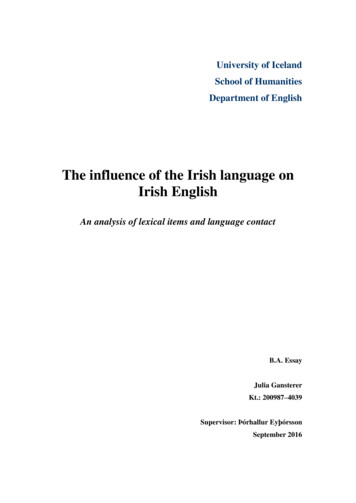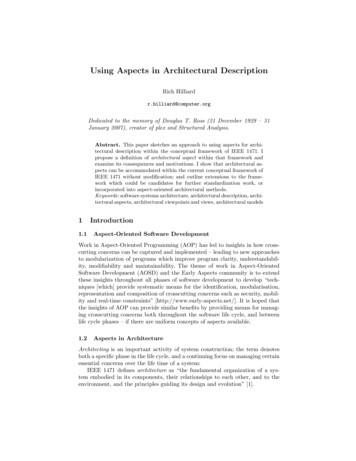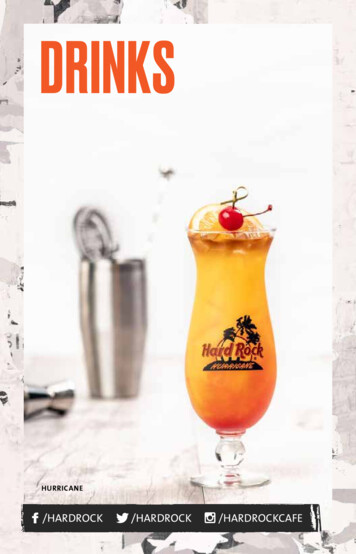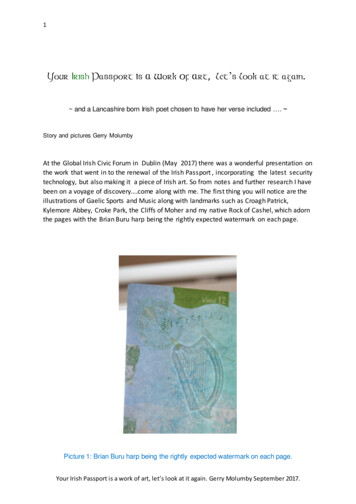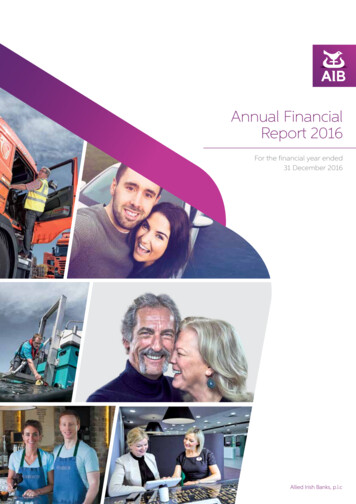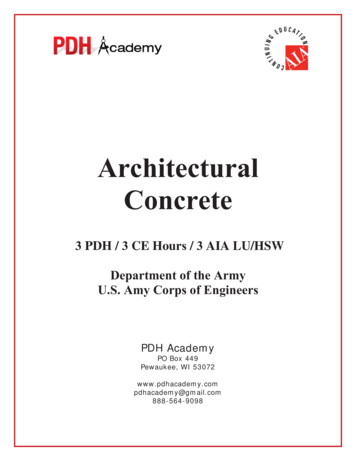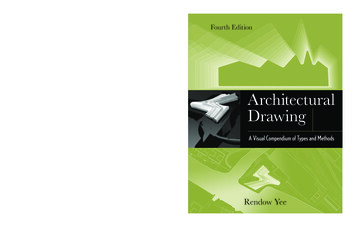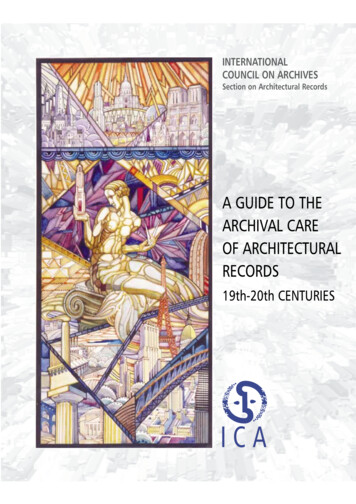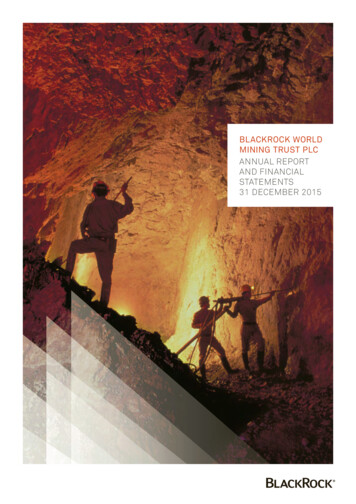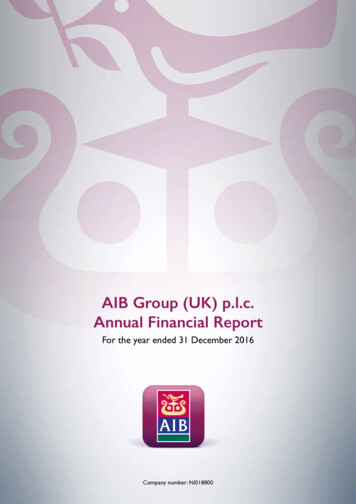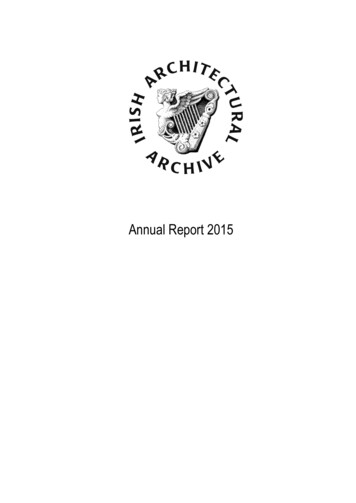
Transcription
Annual Report 2015
Contents:Chairman’s Statementii – xvFinancial Statement1 - 28
Chairman’s StatementIntroduction:This report presents a synopsis of activities in the Irish Architectural Archive for the year 2015.Towards the end of 2015, the board of the Archive adopted a new Strategic Plan. The Plan covers a five year period,starting in 2016, the fortieth anniversary of the establishment of the Archive, and sets out programmes of activity acrossthe full range of Archive operations.The foundation of the Strategic Plan are the Archive’s current work programme and services, the maintenance andstrengthening of which is the sine qua non of everything else that the Plan contains.The Strategic Plan is an ambitious document in its scope, in the resources it seeks to harness, in the amount of work itenvisages, and in the three interlocking goals it seeks to achieve: the consolidation of the achievements of the past fortyyears, the building on those achievements, and the confident assertion of the Archive’s position as a nationally significantcultural resource.The timing of the adoption of the Strategic Plan – the last board meeting of 2015 – is not coincidental. The Plan was indevelopment from early March, and the achievements of the year, be they on the collections development side, or publicengagement in all its forms, fed into the document, raising the sense of what might be attainable while temperingexpectations with the knowledge of just how much hard work it takes to keep the Archive ship afloat.The preparation and adoption of such a wide-ranging and far-reaching document is a signal that the Archive has putrecent difficulties firmly behind it. Restructured and renewed, it is moving forward with a consolidated financial base andthe confidence to plan ambitiously for the next five years.Board:The board of the Archive consisted in 2015 of the following: Malcolm Alexander (Company Secretary), Anne Casement,Ron Cox, William Cumming, Honora Faul, Niall Gaffney, John Graby, Aideen Ireland, Robin Mandal, Aidan O’Connor,Ciaran O’Connor, Michael O’Doherty, Shane O’Toole, John Redmill, Stephen Vernon and Michael Webb (Chairman).Stephen Vernon retired from the Board at the AGM in 2015.We continue to await the nomination by the Minister for Arts, Heritage and the Gaeltacht of three board members.The honorary presidents of the Archive are Edward McParland and Nicholas Robinson.The board met on five occasions during the year. The AGM was held on 12 May 2015.Membership of the Archive board is voluntary and unremunerated.As reported last year, towards the end of 2013 the board initiated a programme to ensure that the Archive was compliantwith the Code of Practice for Good Governance of Community, Voluntary and Charitable Organisations in Ireland(Governance Code, www.governancecode.ie), a voluntary code which is being promoted as the standard definition ofgood practice in governance for the charities sector.In early 2015 the board of the Irish Architectural Archive carried out a review of aspects of governance within theorganisation, prompted by the process of bringing the Archive into compliance with the Governance Code. Arising fromthis review, the board has decided that changes are required to board composition and board rotation in order to bringthe Archive into line with best governance practice. The implementation of these changes requires alterations to theArchive’s Memorandum and Articles of Association, and a resolution implementing the proposed changes will beconsidered by an EGM of the membership called to follow the 2016 AGM.ii
On board composition, the effect of the changes will be to reduce board numbers from a potential nineteen to a maximumof twelve, comprising two ex-officio members (instead of the current five), one ministerial nominee (instead of the currentthree) and up to nine others.With regards to board rotation, the effect will be to establish three-year terms for service on the board, with a maximumof two terms or six years for most individuals. The exceptions to this are Chairmen and Company Secretaries who mayserve for a maximum of three terms (or nine years) and the remaining ex-officio members. As their first term is coterminus with the office they hold, the Chairman of the OPW (or their appointee) will serve for seven years with thepossibility of reappointment for one further three-year term, and the President of the RIAI will serve for two years withthe possibility of reappointment for one further three-year addition. Transition arrangements for the current board arealso stipulated in the proposed changes.As reported in 2014, two new board committees have been constituted: the Audit Committee and the GovernanceCommittee. In 2015, the board created a third committee – the Collections Development Committee.Audit Committee: In 2015 the members of the Audit Committee were Niall Gaffney (Chairman), William Cumming andJohn Graby. The Committee met on 5 May 2015 to review the draft annual accounts. This included a meeting with theexternal auditors without the presence of Archive management.Governance Committee: In 2015 the members of the Governance Committee were Malcolm Alexander (Chairman),Anne Casement and Aideen Ireland. The Committee met on 18 February 2015 and reviewed proposed alterations tothe Memorandum and Articles of Association affecting board membership and rotation. The committee recommendedthat the proposed changes be put to the full board for consideration and adoption.Collections Development Committee: The terms of reference for this committee were agreed by the board at itsSeptember meeting. It is a condition of those terms that the membership include a representative of both the NationalArchives of Ireland and the National Library of Ireland. The relevant Directors each chose to nominate the currentrepresentatives of these organisations on the board. In 2015 the Collections Advisory Committee members were ShaneO’Toole (Chairman), Honora Faul (NLI) and Aideen Ireland (NAI). The committee met on 1 December 2015 and willbring recommendations for additional members to the board after its next meeting scheduled for February 2016.Staff:In 2015 the Archive staff consisted of Colum O’Riordan (General Manager), Aisling Dunne (Archivist), Simon Lincoln(Exhibitions and Outreach Officer), Anne Henderson (Administrative Officer) and Dr Eve McAulay (Archivist andAssistant Editor, Dictionary of Irish Architects).Ann Martha Rowan continued to act in a voluntary capacity as Editor of the Dictionary of Irish Architects.The Archive provided three two-week work placements during the year for individuals interested in pursuing the Mastersin Archival Studies course in UCD, and one transition year work placement.Staff members represented the Archive or served in a personal capacity on the board of the Irish Architecture Foundation(Colum O’Riordan), the Buildings of Ireland Charitable Trust (Colum O’Riordan), DRI Stakeholders Group (ColumO’Riordan), the Merrion Square Innovation Network Steering Committee (Simon Lincoln).Colum O’Riordan attended the ‘What can the digital do for architecture and its history’ symposium in TCD in Januaryand the Department of Arts, Heritage and the Gaeltacht Culture 2025 public consultation event at IMMA in October. EveMcAulay attended the Art in the County House conference, Dublin Castle, in April. Simon Lincoln attended the DublinCity of Culture 2020 bid steering group meeting in June and a digital exhibitions curation workshop in July.The salaries scales of four members of the Archive staff fall into the 50,000 to 60,000 bracket and one into the 40,000to 50,000 bracket.iii
Accessions:The Accessions Register for 2015 contains 125 entries, the vast majority of which were received through the generosityof owners willing to donate material or place items on long-term loan.The following individuals generously donated or loaned material during 2015: Barbara Bingham, Stuart Blakley, MargaretBurke, Vincent Butler, Sarah Chorley, Paul Clerkin, Peter Costello, John Cotter, William Cumming, Joseph Curtis, DavidDeane, Hugh Dixon, Colette Fitzpatrick, Melanie Foot, Bob Frewen, Peter Geraghty, Phyllis Gibney, John MaibenGilmartin, Jennifer Goff, Claire Gogarty, George Gossip, Camilla Gunzl, Kevin Harrington, Roger Hill, Sheila Holloway,Peter Howell, James Howley, Aideen Ireland, Marie Jones, John Kirwan, Bronagh Lawson, John Lenahan, Rolf Loeber,Ernest Long, Marguerite Lorimer, Dell Lundy, Sean Lynch, Sean Lyons, Rosemary MacDonnell, Ken A. Mawhinney,Malachy McCloskey, James McElwee, Patricia McKenna, Emma McVeigh, John Fitzhugh Millar, James Montgomery,Nessa Murray, Feargal O Suilleabhain, Donal O'Brien, Jacqueline O'Brien, John O'Connell, Michael O'Connell, BrendanO'Donoghue, Michael O'Dwyer, Daniel O'Neill, Shane O'Toole, Phil Primack, John Redmill, Kieran Rocks, JohannaRoethe, Eddie Rogan, Alistair Rowan, Matthew Russell, Siobhan Sexton, Julian St. Lawrence, Robert Towers, KlausUnger, F.A.B. Valentine, John Veltri, Simon Walker and Michael Webb.The following organisations are also thanked for their donations: Art Institute of Chicago, Ashgate Publishing, AtlanticPhilanthropies, Central Bank of Ireland, Dedalus Architecture, Domus Magazine, Dublin Civic Trust, Engineers Ireland,Friends of the National Collections (FNCI), Gandon Editions, Health Services Executive (HSE), Historic New OrleansCollection, Lisney Property, Military Archives, National Gallery of Ireland, National Inventory of Architectural Heritage,National Roads Authority, O'Carroll Associates, Office of Public Works (OPW), Anthony Reddy and Associates, theRepresentative Church Body, the Royal Institute of the Architects of Ireland (RIAI), Trustees of the Molyneux Home andYale University Press.Among the year’s most notable accessions were the following:Drawings: Martin Joseph Burke (1877-1953) and Martin Desmond Burke (1916-2011) Collection including drawingsbooks, mss and drawing instruments. Donated by Dr Margaret Burke (2015/2). Front elevation of proposed farmhouse at Belvedere, Co. Westmeath, for Charles Brinsley Marlay (digitalcopy). Donated by Peter Howell (2015/7). Design for a villa ‘to be erected near Dublin’ by R. Elsam (digital copy). Donated by Rolf Loeber (2015/10). Lithograph perspective of Castle Saunderson, Co. Cavan. Donated by Hugh Dixon (2015/14). Reddy Architecture drawings collection. Donated by Reddy Architecture (2015/18). ESB architectural competition entry by Herbert Unger. Donated by Klaus Unger (2015/27). Sketches, drawings and research notes by Arthur Gibney. Donated by Phyllis Gibney (2015/29). Raymond MacDonnell, architect, collection. Donated by the MacDonnell family (2015/30). Drawings for the Ulster Museum, Belfast, by Paddy Lawson and others. Donated by Bronagh Lawson(2015/37). Drawings for Howth Castle by Edwin Lutyens. Loaned for copying by Julian St Lawrence (2015/48). Dublin Artisans Dwellings Company drawings. Donated by the Military Archives (2015/68). J.S. Deane, architect, collection. Donated by David Deane (2015/78). Drawings from Howley Hayes Architects. Donated by James Howley (2015/81). O’Carroll Associates collection. Donated by O’Carroll Associates (2015/91). Survey drawings of Tyrone House, Dublin, Islandmore House, Co. Limerick, and Gigginstown House, Co.Westmeath. Donated by Roger Hill (2015/101). Watercolour perspective drawings of Limerick Regional Hospital and proposed courthouse, Limerick, by CyrilFarey. Donated by John Maiben Gilmartin via the FNCI in memory of Jeremy Williams (2015/106).iv
Photographs: Photographs of Turvey, Co. Dublin, 1971. Donated by John Lenahan (2015/12). Photographs of various houses in Northern Ireland by Stuart Blakley. Donated by Stuart Blakley (2015/26). Framed portrait photograph of Alfred E. Jones, architect. Donated by Marie Jones (2015/33). Vaclav Otto Gunzl photographs (digital copies). Donated by Camilla Gunzl (2015/42). Dublin Civic Trust photographic collection. Donated by the Dublin Civic Trust (2015/74). Vincent Butler photographic collection (digital copies). Donated by Vincent Butler (2015/79). Photographs of various buildings by J.F. Fuller. Donated by Bob Frewen (2015/85). Photographic portrait of C.W. Harrison, 1856. Donated by Sheila Holloway (2015/89). Photographs of Archer’s Garage being demolished (digital images). Donated by Paul Clerkin (2015/90). Photograph of Methodist Chapel, South Circular Road, Dublin, c.1900. Donated by the RepresentativeChurch Body (2015/104). Jacqueline O’Brien photographic collection. Donated by Jacqueline O’Brien (2015/115).Manuscripts: Annotated proof copies of Classic Irish Houses of the Middle Size by Maurice Craig. Donated by JohnO’Connell (2015/13). Documents relating to gates and lodges by Sir George Hodson. Donated by Phil Primack (2015/41). Institution of Civil Engineers of Ireland (ICEI)/Institution of Engineers (IEI) archives. Donated by EngineersIreland (2015/43). F.H. Tallon Collection – diary, letter-book and collection of trade catalogues. Donated by John Lyons(2015/60).Books, pamphlets, & reports: The Houses and Landed Families of Westmeath, Donal O’Brien, Athlone, 2014. Donated by Donal O’Brien(2015/3). Gone but not forgotten: the life and career of John Bourke, architect, Colette Fitzpatrick, TCD undergraduatethesis, 2013. Donated by Colette Fitzpatrick (2015/8). A Sense of Place and Other Essays by Robin Walker, Dublin 2015. Donated by Simon Walker (2015/32). Books of architectural interest. Donated by Brendan O’Donoghue (2015/38). From Village to Suburb: the Buildings of Clontarf since 1760, Claire Gogarty, Dublin, 2014. Donated by ClaireGogarty (2015/47). Adare: The Augustinian Friary and St Nicholas Church, Barbara Bingham, London, 2015. Donated byBarbara Bingham (2015/65). Medieval Ecclesiastical Buildings in Ireland, Niamh Nic Gabhann, Dublin, 2015. Donated by Niamh NicGabhann (2015/70). Eileen Gray: her work and her world, Jennifer Goff, Dublin, 2015. Donated by Jennifer Goff (2015/73). John M. Johansen: A Life in the Continuum of Modern Architecture, John M. Johansen, Milan, 1995. Donatedby Marguerite Lorimer and John Veltri (2015/84). Books of architectural interest. Donated by Ken Mawhinney (2015/95). Sale catalogue for Clobemon Hall, Co. Wexford, 1930. Donated by F.A.B. Valentine (2015/98).v
Books of architectural interest. Donated by Peter Costello (2015/100). Pamphlets and press cuttings of architectural interest. Donated by Joe Curtis (2015/102). Niall Montgomery: Dubliner. Selected Writings, Christine O’Neill ed., Dublin, 2015. Donated by JamesMontgomery (2015/111). Department of Education secondary school design brief and competition assessors’ report. Donated byWilliam Cumming (2015/119). Instructions for Obtaining Loans under the Land Improvements Acts, London, 1876. Donated by SarahChorley (2015/123).Models: Model of Molyneux Home, Leeson Park, Dublin, and perspective drawing for same. Loaned by the MolyneuxHome Trustees (2015/23). Model of PMPA building, Wolfe Tone Street, Dublin. Donated by Simon Walker (2015/44).Other: Two films detailing the construction of the Central Bank, Dame Street, Dublin (digital copies) Donated by theCentral Bank (2014/25). Goad Insurance Maps, Dublin, c.1905-c.1960. Donated by Lisney Property (2015/63). Video recordings of interviews with Kevin Roche by Andy O’Mahony of RTE. Donated by Shane O’Toole(2015/86). Film of stone conservation work at Courthouse, Washington Street, Cork (1997-99), and Carton Co. Kildare(2000) (digital copies). Donated by John Cotter (2015/103).Photography and Professional Services:The Archive is mandated by its Articles of Association to record Ireland’s architecture. To accomplish this, the Archiveshould undertake, on an ongoing basis, a coherent and systematic programme of record photography. In addition theArchive needs to be able to carry out reactive or emergency photography to record buildings in danger of substantialalteration or demolition. The Archive’s Survey Work Policy Statement sets out the parameters governing theseactivities.For some time now, due to a variety of factors including severe budgetary restraints, very little survey work has beenundertaken. However, in 2015 the board established a new Collections Development Committee, the functions of whichwill include reviewing Archive photographic activity and make recommendations regarding possible buildings/areaswhere photography is required. This is a first, essential step toward reactivating a survey photograph programme.As in previous years the Archive continued to augment its photographic holdings through accessions and loans forcopying. Particularly noteworthy in this regard is the donation of the Dublin Civic Trust photographic archive, the donationby Jacqueline O’Brien of the original transparencies and negatives for her architectural photographs, and the loaningfor copying by Julian St Lawrence of drawings by Edwin Lutyens for Howth Castle.The Archive continued to provide professional archival, architectural history and records management advice to theOffice of Public Works as requested.vi
Researcher services:Over the course of 2015, the Archive registered 455 new readers, a slight increase on 2014 (428). This brought the totalnumber of individuals registered with the Archive to 7,447 by year’s end. New and existing readers made 2,855 researchvisits to the Reading Room in 2015.The monthly breakdown was as 1682,855The daily average in 2015 was just over 15.5.Aside from accessing the books, journals and photographs in the Reading Room, readers requested access to over1,160 containers (boxes, folders etc) of archival material (drawings, mss, photographs) and reserve-access items ofprinted matter (pamphlets and press-cuttings files). Sixty photographic orders were processed, with over 800 digitalcopies of photographs or drawings supplied, in addition to the copy photography allowed in the reading room.As well as daily personal introductory sessions for new readers, the Archive provided twelve introductory group sessionsto more than 240 students ranging from transition year to postgraduate level over the course of the year.Cataloguing and indexing:As detailed in my last annual report, the Archive took major strides in 2014 towards its long term goal of making itscatalogue available online. In 2015, I am delighted to say, this process was completed. This is a huge step for theArchive, one which involved not simply providing a new internet front to the old catalogue but rather a fundamentalrebuilding of the old catalogue and its transfer into a new cataloguing system – Adlib ALM. A great deal of this work hadbeen undertaken in 2014 but it continued well into 2015.A major obstacle almost derailed the project when it became apparent that the Archive’s main computer server – in itstenth year of operation – might not be able to cope with the new cataloguing software. The server was coaxed intocooperation, but a decision was taken to upgrade. In December a new server was installed, funded by donation frommembers. This provides a robust platform for the catalogue, and a vastly increased capacity to hold the Archive’s evergrowing digital collections.As a solution to the provision of online access to the catalogue, it was decided to use a cloud-based server or virtualmachine. This was established on the Microsoft Azure platform, and now hosts not only the online catalogue but alsoboth the Archive’s own website and the Dictionary of Irish Architects website. The public computers in the ReadingRoom were also upgraded during 2015 as the old machines (12 year old pcs running Windows XP) could not connectto the online catalogue.In May the Archive staff received two days of intensive training on the new catalogue software, and cataloguing projects,suspended for the duration of the transfer process, were resumed. Some 219 items were added to the cataloguebetween May and December 2015. The main Archive catalogue has been accessible online at http://iarc.cloudapp.netsince August 2015.We continued throughout the year to monitor developments in digital archives and preservation, but did not secure thefunding necessary to advance our proposal to create our own Digital Repository to facilitate the acquisition of the borndigital output of contemporary architectural practices.vii
Dictionary of Irish Architects:The Dictionary of Irish Architects continues to be one of the Archive’s principal online resources and perhaps its mostsignificant project.Between 1 January and 31 December 2015, 66,980 individuals visited the Dictionary of Irish Architects (www.dia.ie)91,992 times and viewed 234,880 pages of information. This compares with 62,771 visitors, 86,551 visits, and 235,792pages viewed for the same period in 2014.Ann Martha Rowan, the creator and Editor of the DIA, continues to work on the project in a purely voluntary capacity,correcting data and inputting new information relevant to the initial time limitations of 1720 to 1940. Dr Eve McAulaycontinues as assistant editor, though, for most of 2015 the hope that she would be able to devote 1.5 days of her workingweek to the project proved impossible due primarily to the pressing demands and deadlines of the catalogue on-lineproject. If the goals of expanding the database back to 1600 and forward beyond 1940 are to be realised, the freeing upof Dr MacAulay’s time to work on the Dictionary of Irish Architects is essential.Storage and premises:As I have been reporting for a number of years now, the Archive is facing an ongoing storage problem. The archivesstores in No. 45 consist of special air-conditioned strong-rooms which house the photographic collections and largerstate-of-the-art ‘passive’ stores which house our paper material amounting now to some 2.5 million drawings and relateddocuments. The passive stores, built semi-underground to the rear of No. 45, are designed to provide the requiredinternal environment for the long term storage of paper documents without the need for mechanical air-handling. Theyare highly cost-effective to operate, pioneering the provision in Ireland of a fully sustainable solution to heritagepreservation.We are confident that the air-conditioned photographic stores in the basement of No. 45 have sufficient capacity for ourforeseeable needs. However, the passive repository may be regarded as a victim of its own success. Creators andowners have been more willing than ever to donate material to the Archive’s care, confident not only of theprofessionalism of the Archive staff but also of the quality of the protective environment in which the collections willreside. The result is that the purpose-built passive stores are now full. In addition, a great deal of material is stored invarious areas of 45 Merrion Square which were not originally intended for this purpose. Not only is this far from ideal forthe material itself, as these areas lack environmental controls, but it also means that the functions which those roomswere initially intended to accommodate now lack operational space in the building. This includes archive processingspace: there is no room left to carry out the detailed cataloguing work essential to making material publically accessible.While the storage of material in non-storage areas of 45 Merrion Square is less than ideal, far worse is the storage ofmaterial off-site in two shipping containers. This emerged in 2010 as an emergency response to the potential loss of thecollection of a large architectural practice. These containers offer nothing but the most meagre protection to the materialthey house and their use must be discontinued as a matter of priority. I am pleased to be able to report that for the thirdyear in a row we were able to avoid adding to the material stored there. Instead, through careful rearrangement ofmaterial on site, we were again able to accommodate all of the year’s acquisitions in No. 45 Merrion Square.The obvious solution to the storage issue is to advance Phase II of the passive archives stores to the rear of 45 MerrionSquare. The 45 Merrion Square project was always intended to be one which would require several phases to complete.Phase I, the conservation of the main house and the construction of the first stage of the semi-underground passivearchival stores, was completed in 2005. Phase II should see the construction of the second stage of the passive storesbehind the main house, and Phase III will ultimately follow with the rebuilding of the mews to the rear of No. 45 to provideenhanced public facilities, a conservation lab and specialist storage. In 2008 the OPW undertook an architecturalinvestigation of Phase II of the archive stores, fully costing the project and preparing drawings. The total cost wasestimated at less than 1,000,000. At the point where a planning application was ready to be made, the economicdownturn prevented any further progress.Making significant progress on advancing Phase II is the central ambition of the Strategic Plan 2016-2020, and we havewritten to both the Minister for Arts, Heritage and the Gaeltacht and the Minster of State at the OPW requesting that theproject be reactivated.viii
With regard to the maintenance of the premises we are yet again indebted to the Office of Public Works which continuesto support the maintenance of the physical fabric of No. 45 Merrion Square, addressing issues as they arise promptlyand with consummate professionalism.Exhibitions:Once again, 2014 was a very full year on the exhibitions front. In the Architecture Gallery, our exhibition on the USEmbassy building in Ballsbridge closed at the end of January. This was followed by an exhibition of photographs byDenis Mortell, another in the Archive’s continuing series of exhibitions exploring the interface of architecture andphotography. Next, we hosted the Ulster Museum’s exhibition detailing the evolution of its building, in particular the1960s brutalist extension. The architecture of St Patrick’s Cathedral, Dublin, was explored in drawings and photographsover the summer in an exhibition marking the 150th anniversary of the restoration works carried out by Benjamin LeeGuinness. We marked the 180th anniversary of the birth of James Franklin Fuller over the summer before returning tothe theme of architecture and photography at the end of the year with an exhibition of works by Cork-based artist andphotographer Harry Moore.In the first floor rooms, we hosted Simon Walker’s exhibition of models and photographs detailing the work of his father,the architect Robin Walker, and followed this with Michael Fewer’s exhibition on the life and architecture of T.J. Byrne.We hosted the Irish Landscape Institute’s awards show in the first floor rooms, and let the space to the Paul Kane Galleryfor an exhibition of paintings by the artist Zita Rehill. We also loaned our largest model, the Sheraton Hotel, conferencecentre and casino project proposed for the Phoenix Park Racecourse site, to an exhibition entitled Reverse!Pugincurated by Sean Lynch, Lismore Castle Arts, Oct - Dec 2015.The complete exhibition and lecture programme was as follows:Stations of Indifference: Photographs by Denis MortellArchitecture GalleryFebruary - March 2015The aim of this series of fourteen photographs of abandoned petrol stations is to offer a fresh take on a well-establishedphotographic theme: Photographs of a Man-Altered Landscape. This was the sub-title of the New Topographicsexhibition which William Jenkins curated at the International Museum of Photography, George Eastman House(Rochester, New York) in January 1975. As Jenkins termed it in his introduction to the New Topographics catalogue, theman-altered landscape is a place where ‘actual, physical subject matter and conceptual or referential subject matter’coincide. This series of fourteen images attempts to examine this concept metaphorically by reflecting on theconsequences of mass production and how we sometimes cannot control it, or get rid of it; the quasi-religiositysurrounding oil; and what elements in a man-altered landscape the stations have to offer aesthetically.This work prioritises concept over aesthetic, which is so often the case in conceptual photography, by creating imagesthat, first and foremost, visually engage the viewer.This exhibition was part of the Archive’s ongoing exploration of the relationship between photography and architecture.Denis Mortell delivered an artist’s talk on his Stations of Indifference photographs on 7 February 2015.Ulster Museum: Evolution amidst RevolutionArchitecture GalleryMarch - May 2015The Ulster Museum as it stands today, set within the Botanic Gardens in Belfast, is the result of three main phases ofdevelopment which, remarkably, coincide with defining periods in the history of the province: the birth of NorthernIreland, the outbreak of ‘The Troubles’ and post-Good Friday Agreement. However, the museum has evolved not onlyamidst political revolution, but also during a time of radical change within architecture.Curated by Rosaleen Hickey and first shown in Belfast in 2014, this exhibition was originally organised in collaborationwith the 2014 Venice Architecture Biennale. The theme of that Biennale was ‘Absorbing Modernity: 1914–2014’ and bycasting your eye from right to left across the Ulster Museum’s north façade you can see the literal representation of thistheme.ix
As an exploration of the evolution of architectural styles across the twentieth century – from Edwardian Classicism to1960s modernist Brutalism – this exhibition was a worthy addition to the Irish Design 2015 programme.Arising out of this exhibition, Bronagh Lawson, daughter of architect Paddy Lawson, donated to the Archive an importantcollection of original drawings by Paddy Lawson and others for the Ulster Museum extension.Lectures and events to accompan
Colum O'Riordan attended the 'What can the digital do for architecture and its history' symposium in TCD in January . James McElwee, Patricia McKenna, Emma McVeigh, John Fitzhugh Millar, James Montgomery, Nessa Murray, Feargal O Suilleabhain, Donal O'Brien, Jacqueline O'Brien, John O'Connell, Michael O'Connell, Brendan . Art Institute .
